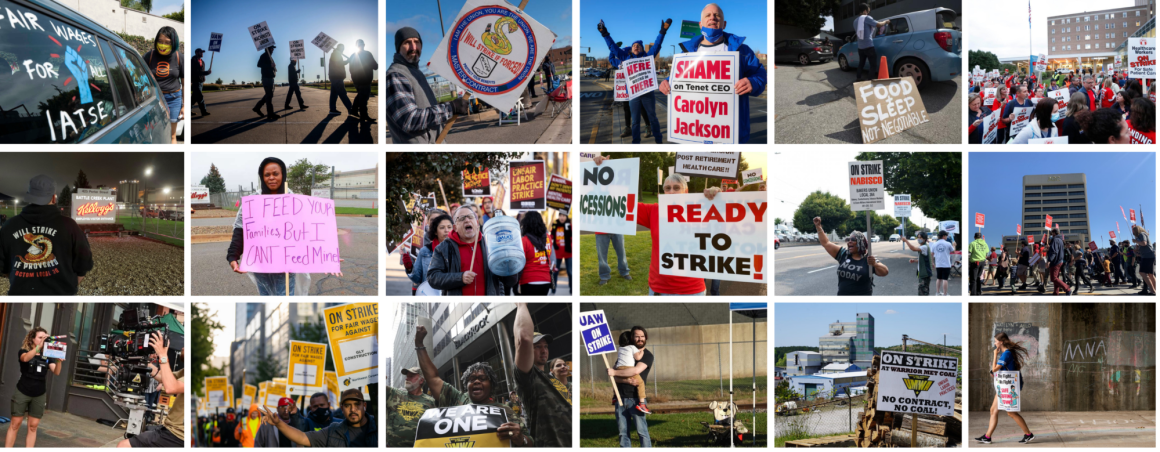By Stephen Edwards, Socialist Alternative (our sister organisation in the United States)
After 18 months of working conditions more dangerous than any in living memory, and exhausted by the sped-up pace of work under the pandemic, workers are fighting back. Encouraged by the labor shortage that’s developed in the economic recovery, and despite a vacuum of leadership from organized labor, workers have picked up where the 2018-9 strike wave left off. There have been at least 178 strikes so far this year.
The nurses’ strike at St Vincent hospital in Worcester, MA is now going into its eighth month; coal miners at Warrior Met in Alabama, six months; plant workers with BCGTM have gone on three consecutive strikes against snack food giants, first at Frito-Lay, then Nabisco, and now Kellogg’s.
Since October 13th, 10,000 John Deere workers have been on strike after a 90% vote to reject a concessionary, job-killing contract that was recommended by union leaders. As we go to press, IATSE’s 60,000 members may vote down a proposed contract which fails to resolve key issues like unsafe and excessive hours. At Kaiser healthcare, 37,000 workers in Oregon, California, and Hawaii have been taking strike votes against the employer’s attempt to impose a two-tier wage system.
Workers rediscovering the strike
Most of these workers are striking for the first time in their lives. The common thread is that employers are pushing to maintain the breakneck pace that developed during the pandemic and even attacking existing rights like paying for all of that overtime. The bosses never let a crisis go to waste, and will point to supply chain disruptions and high demand to justify putting the cost on their workers. But inflation has kicked in and is eating into workers’ pay. The labor shortage also means workers are more confident that they can’t be easily replaced.
The idea has become popular on social media that “Striketober” represents an inchoate general strike. While the current strike wave is a dramatic departure from the historic low levels of the past three decades, the number of strikes and of strikers is still low compared to the historic highs in the 1930’s and 40’s and again in the wake of the civil rights and anti-war movements in the 60’s and 70’s. And while the “great resignation” has forced some employers to raise pay in order to maintain staffing levels, these gains are a pittance compared to what could be won if more workers were organized, and without a union contract these gains can be taken back whenever the labor market eases.
Where are the union leaders?
Union leaders, unable to see beyond the bosses’ profit-seeking logic, have been taken by surprise. Where they have fought back effectively has been in unions with a particularly active rank-and-file, for example in education and healthcare.
Elsewhere, powerful industrial unions have acted as though they have no leverage. Instead of stepping up to stop production, their traditional, passive tactic of “one day longer” puts pressure on workers and their families to go back to work with only marginal relief from substandard contracts. Many of these bad contracts are lasting – five and six years – with raises that will not keep up with inflation, therefore essentially representing long-term pay cuts. For union leaders to allow this is a gross dereliction.
There would be a far bigger and more effective strike wave if more of the working class (especially in the private sector) were organized behind a fighting leadership. This is the big question that faces the labor movement. With millions of workers ready to fight, this should be an ideal opportunity for a major organizing drive. But the way strikes are playing out is showing us what we’re up against in making this happen. In the recent Seattle carpenters’ strike, the Frito-Lay and Nabisco strikes, and now with John Deere, militant tactics have been actively discouraged by union leaders who argue for “safe, legal and respectful” picket lines, minimal communication between worksites, and overall a conciliatory strategy that points away from class struggle and winning through disrupting production.
Many of these union leaders have lost touch with their membership through decades of defeat. There was a time when the United Auto Workers was a fighting vehicle for workers to win big victories against the bosses. Today, the Administration Caucus, the leadership clique which has run the UAW since WWII have repeatedly caved to corporate demands for concessions, like the two-tier contracts which slashed living standards and divided workers generationally ever since the 1980s.
This happened because these leaders, despite whatever good intentions they may have had, rejected any alternative to accepting “market realities.” Years before the Reagan administration’s attacks on unions, the UAW was instrumental to the 1979 Chrysler bailout, in which — instead of fighting for that bankrupt corporation to be taken into public ownership under democratic and workers’ control — the union used its authority to argue that workers needed to forego raises and work “smarter” in order to beat the competition and save jobs.
This is the cancer that led to the UAW’s astonishing miscalculation in pushing a concessionary contract at John Deere, and it underlies the blindness of many union leaders to the potential for mass action to recover these past losses.
Much more can be won!
What’s needed are unions organizing en masse and showing they’re prepared to fight. This is the opportunity to begin to turn the page on four decades of setbacks and retreat, and as reports from the John Deere and Kellogg picket lines show, striking workers understand this. The idea of recovering past losses is what drove the 2019 GM strike, and the current labor shortage strengthens workers’ resolve because of how badly the bosses need our labor.
Workers will fight and are prepared to make sacrifices to win demands that are worth fighting for. This means an end to concessionary bargaining and zero tolerance for union leaders’ lowering of expectations and hiding behind court injunctions as an excuse for ineffective picketing. We need:
- Serious pay increases that raise living standards
- No more 12 and 16 hour shifts, no more multi-tier pay and pension schemes that divide workers against each other.
- Strikes must be organized to stop production and win. This means breaking anti-picketing injunctions and a return to the mass action tactics that built the unions and the civil rights movement.
- Where union leaders refuse to do this, they have to be challenged in an organized way. This means building opposition caucuses that don’t wait on union elections but – as rank and file union members did in the 2018 Red for Ed strikes or in the recent carpenters’ strike in Seattle – taking the initiative to broaden strikes, strengthen picketing and insist that workers don’t cross the line.
- Rank and file members need to demand that union leaders launch a massive drive to organize the unorganized in key industries. There has never been a better time.












